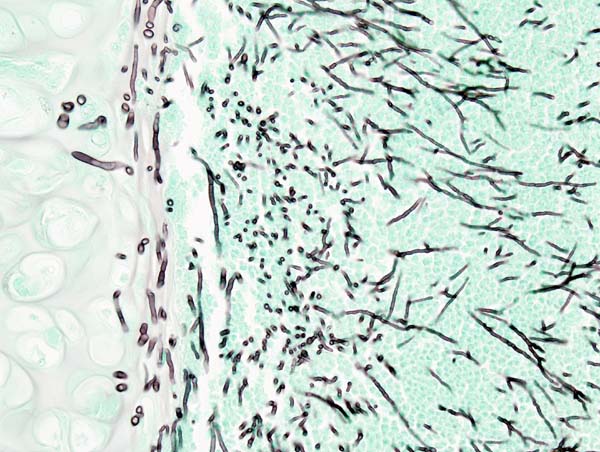Aspergillosis, Susceptibility To

A number sign (#) is used with this entry because of evidence that susceptibility to invasive aspergillosis following hematopoietic stem cell transplantation is influenced by variation in the C-type lectins CLEC7A (606264) and CLEC1A (606782) on chromosome 12p13.
DescriptionAspergillus species are ubiquitous in nature and cause a wide spectrum of diseases, including saprophytic colonization of existing cavities (aspergilloma), allergic asthma, hypersensitivity pneumonitis, allergic bronchopulmonary aspergillosis, and disseminated disease associated with high mortality rates in patients with hematologic malignancies and recipients of solid organs and stem cell transplantations. Immunocompetent and nonatopic individuals are relatively resistant to infection, and disease occurs in the setting of host damage. Association of persistent inflammation with intractable infection is common in nonneutropenic patients after hematopoietic stem cell transplantation, as well as in allergic fungal diseases. The pathophysiology underlying Aspergillus infection highlights the bipolar nature of the inflammatory process in infection, in which early inflammation prevents or limits infection, but an uncontrolled response may oppose disease eradication (summary by Cunha et al., 2010).
For information on familial occurrence of allergic bronchopulmonary aspergillosis, see 103920.
MappingCunha et al. (2010) showed that susceptibility to invasive aspergillosis following hematopoietic stem cell transplantation is associated with a polymorphism in the dectin-1 gene (CLEC7A; 606264), which maps to chromosome 12p13.2-p12 (Yokota et al., 2001; Hernanz-Falcon et al., 2001).
Molecular GeneticsVariation in CLEC7A
Cunha et al. (2010) studied 205 patients with hematologic malignancies who underwent T cell-depleted hematopoietic stem cell transplantation in an Italian hospital. They found that the presence of a dectin-1 (encoded by CLEC7A) tyr238-to-ter (Y238X; 606264.0001) polymorphism in either donors or recipients of hematopoietic stem cell transplantation increased susceptibility to invasive aspergillosis. The risk was highest when Y238X was present in both donors and recipients (adjusted hazard ratio = 3.9; p = 0.005). Cunha et al. (2010) showed that the Y238X polymorphism impaired production of multiple cytokines, including IFNG (147570), IL10 (124092), IL1B (147720), IL6 (147620), and IL17A (603149) by human peripheral mononuclear cells stimulated with beta-glucan or Aspergillus conidia. Furthermore, DECTIN1 contributed to fungal recognition on human bronchial epithelial cells, and these effects were abrogated by small interfering RNA against DECTIN1. Studies of Aspergillus infection in Dectin1 -/- mice supported the findings in human patients. Cunha et al. (2010) concluded that the Y238X polymorphism is associated with invasive aspergillosis in hematopoietic stem cell transplantation through impairment of both recipient- and donor-dependent mechanisms of antifungal immunity.
Variation in CLEC1A
Stappers et al. (2018) identified a single-nucleotide polymorphism (SNP) in CLEC1A, rs2306894 (606782.0001) that was associated with susceptibility to aspergillosis in stem-cell transplant recipients (614079) when the variant was carried by the donor, not the recipient (p = 0.003), in a comparison of the incidence of invasive aspergillosis after transplantation according to donor (238 wildtype, 72 risk allele-carrying individuals) or recipient (228 wildtype, 80 risk allele-carrying individuals) genotype at rs2306894. Stappers et al. (2018) found that macrophages from individuals carrying this SNP produced significantly less IL1-beta (147720) and IL8 (146930) after in vitro stimulation with A. fumigatus conidia compared to controls, whereas there was no difference in response upon stimulation with lipopolysaccharide. Stappers et al. (2018) concluded that in humans, the protective functions of MelLec are primarily mediated by myeloid cells.
Associations Pending Confirmation
By analyzing SNPs in 4 Toll-like receptor (TLR) genes in a discovery study of 336 recipients of hematopoietic cell transplants and their unrelated donors, Bochud et al. (2008) found that 2 donor TLR4 (603030) haplotypes increased the risk of invasive aspergillosis in recipients. A validation study with 103 patients and 263 matched controls who received transplants from related and unrelated donors confirmed that the donor TLR4 S4 haplotype was associated with increased risk of invasive aspergillosis in unrelated recipients. TLR4 haplotype S4 is defined by 4 SNPs, including 2 coding SNPs, asp299 to gly (D299G; 603030.0001) and thr399 to ile (T399I; 603030.0002), in strong linkage disequilibrium in exon 3 that influence TLR4 function. The discovery study indicated that donor or recipient cytomegalovirus (CMV) seropositivity, donor S4 positivity, or both, were associated with increased probability of invasive aspergillosis within 3 years and death unrelated to relapse compared with negative results for CMV and S4. Bochud et al. (2008) concluded that donor TLR4 S4 haplotype is associated with risk of invasive aspergillosis among unrelated recipients after allogeneic hematopoietic cell transplantation, and they proposed that the risk can be reduced for transplant recipients by identifying unrelated donors with an increased risk of severe infection. In a commentary, Pamer (2008) suggested that persons receiving transplants from donors with a high-affinity TLR4 variant may acquire an elevated innate immune tone, increasing general resistance to infection.
In response to the findings of Bochud et al. (2008), correspondents suggested several potential confounding factors to the study, including the immunomodulatory properties of the antifungal agent amphotericin B (Levitz et al., 2009), the potential of the cytomegalovirus association with aspergillosis to act as an intermediate variable (Cervera et al., 2009), and the fact that invasive aspergillosis still develops in Asian patients after undergoing allogeneic hematopoietic stem cell transplantation, even though the D299G and T399I polymorphisms are absent in Asian populations (Asakura and Komatsu, 2009). Bochud et al. (2009) replied that the D299I polymorphism is also associated with cavitary aspergillosis in patients without exposure to amphotericin B, citing the findings of Carvalho et al. (2008). They pointed out that multivariate analysis in their study did not support an association with CMV. Bochud et al. (2009) acknowledged that inherited risks are likely to be multifactorial and to differ among specific ethnic groups, in part due to the complex cell wall structure of fungi that may interact with different receptors. They noted the influence of IL10 with susceptibility to invasive aspergillosis in Koreans (Seo et al., 2005).